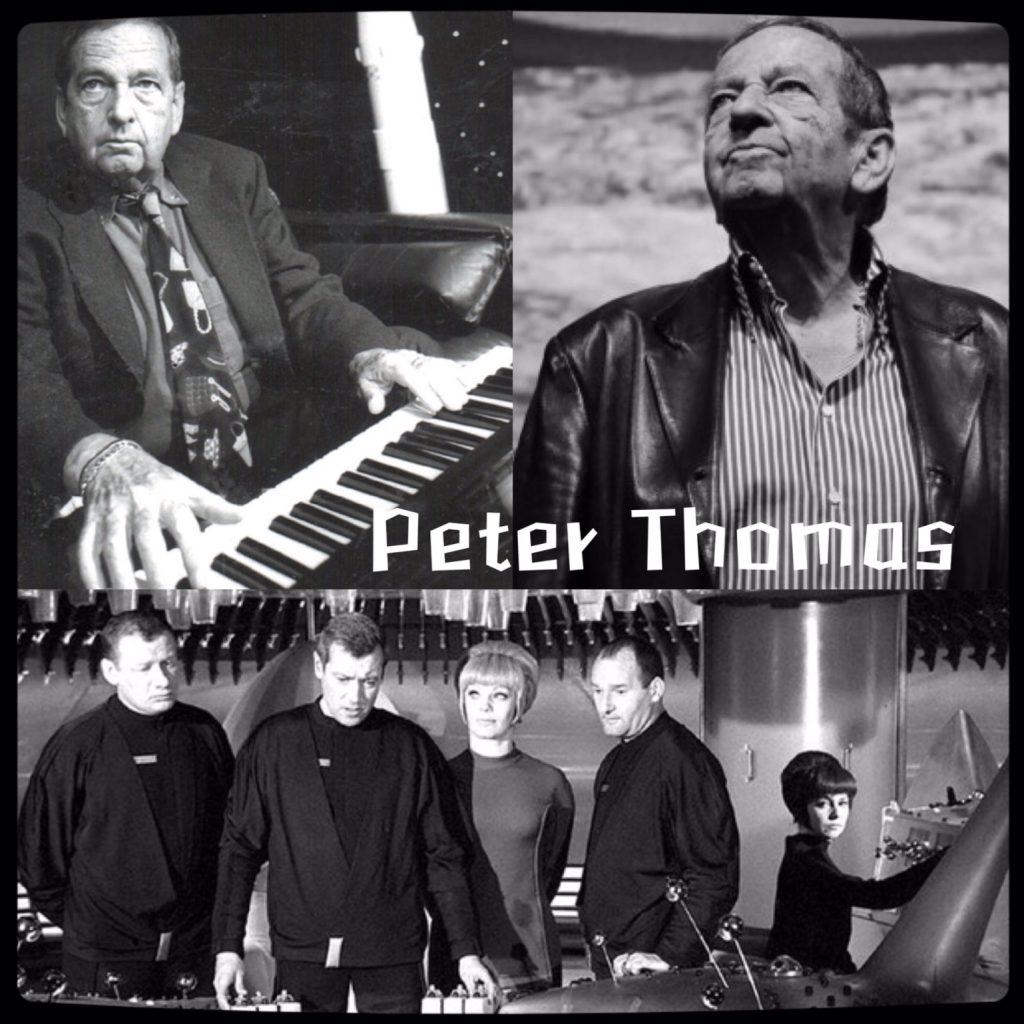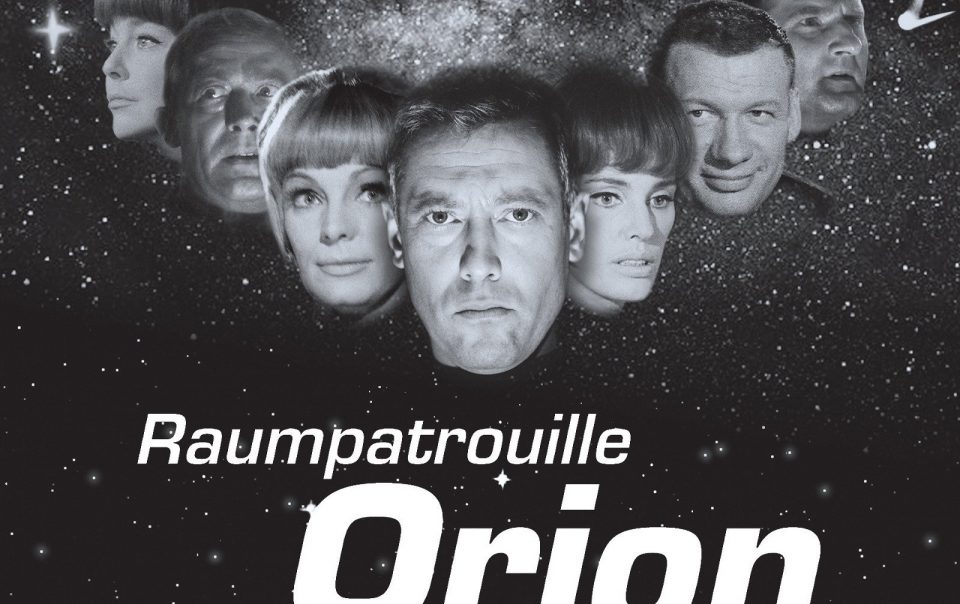What sounds like a fairy tale today may be reality tomorrow.
Hier ist ein Märchen von übermorgen. Es gibt keine Nationalstaaten mehr, es gibt nur noch die Menschheit und ihre Kolonien im Weltraum. Menschen siedeln auf fernen Sternen. Der Meeresboden wird als Lebensraum erschlossen. Mit heute noch unvorstellbaren Geschwindigkeiten eilen Raumschiffe durch unser Milchstraßensystem. Eines dieser Raumschiffe ist die Orion. Winziger Teil eines gigantischen Sicherheitssystems, das die Erde vor Bedrohungen aus dem All schützt. Begleiten wir die Orion und ihre Besatzung auf ihrem Patrouillendienst am Rande der Unendlichkeit und entdecken wir in den nächsten Wochen einen ganz wichtigen und entscheidenden Eckpfeiler in der Karriere von Peter Thomas: Seine Musik für die erfolgreiche TV-Serie “Raumpatrouille Orion”.
The musical world of Space Patrol Orion
Wir geben Ihnen einen Einblick in die musikalische Welt von Orion, werfen einen Blick hinter die Kulissen der TV-Produktion, stellen Ihnen die Protagonisten vor und erzählen die Geschichte auf eine neue Art und Weise.
Space Patrol Orion läuft derzeit auf Netflix – hier können Sie die Serie noch einmal sehen. Der Rechteinhaber Bavaria Film bereitet ein Reboot vor. “Orion” ist der schlichte Titel der Gemeinschaftsproduktion von Uncharted Territory und Bavaria Fiction. Die Handlung wird sich an der der Originalserie orientieren, im Vorfeld hatte das renommierte amerikanische Branchenmagazin Variety bereits über die Pläne berichtet.
Doch nun tauchen Sie mit uns ein in die unendlichen Weiten, die Commander McLane und seine Crew entdecken und bei denen sie von der großartigen Musik von Peter Thomas begleitet werden.
The recordings of Raumpatrouille Orion
Peter Thomas needed only five days for the recordings. The financial resources were limited, but he was able to act freely musically. Thomas recalls, “the producers had a certain budget and said, ‘Do somethPeter Thomas had the ambition to write music “from the moon”, i.e. to compose music as it might actually be played in the future, using the existing musical and instrumental possibilities. Thus, apart from the vocoder for the countdown and the Hammond organ (apart from the electric guitar and electric bass), no electronic instruments were used. Peter Thomas did not intend to create a symphonic sound world like John Williams did for Star Wars. He also did not have the financial means for this production. He made a virtue out of (financial) necessity: in lean but refined arrangements he combined the instruments of a beat or rock band with a few characteristic orchestral instruments. As the central instrument running through the entire composition, however, he used the Hammond organ, which at the time was still – musically speaking – a “foreign body” for the general public. With its diverse sound possibilities and the floating and vibrating Leslie sound, it was perfectly suited to musically underscore eerie, dangerous or dramatic scenes. At the same time, it fit ideally into the band context.
ing with it.’ It was very important to finish on time, but otherwise I had every freedom. “The recordings were then made in Munich, at the Bavaria Tonstudio in Schornstraße. One of the best sound engineers, Hans Endrulat (who later also recorded the music for “Cabaret”), was there. The technical possibilities at that time only allowed a two-track recording (technical term: “shoestring”), so everything had to be recorded in one go. Thomas remembers: “Everything was recorded live. That way I knew immediately how it sounded, and each musician also played better. He wasn’t allowed to make a mistake. One mistake is okay, the second he gets a warning, and the third he gets fired. You play better with fear.” Often, the music was played directly to the film in progress.

Broadcast
“The Fantastic Adventures of the Spaceship Orion” is the first and best-known German science fiction television series. It was broadcast by ARD in seven parts every fortnight on Saturday evenings after the Tagesschau from 17 September 1966. The series, which cost an immense DM 480,000 per episode for its time, was created as a Franco-German co-production between WDR and the public broadcaster ORTF (Office de Radiodiffusion Télévision Française), where it was shown under the title “Commando Spatiale”. Although there were only seven one-hour episodes, the black-and-white series has enjoyed cult status for decades. When it was first broadcast on ARD, it achieved ratings of up to 56% and was therefore often referred to as a street sweeper. In Germany, the series was repeated more than 35 times on German television and by various regional broadcasters such as WDR, NDR Fernsehen, hr-fernsehen and the then Südwest 3 as well as the private broadcaster Sat.1.
In addition, there were special film screenings in the 1980s and 1990s, especially in arthouse cinemas, where the seven episodes were usually shown in two runs. In 2003, the 90-minute compilation Raumpatrouille Orion: Rücksturz ins Kino was even edited with newly filmed scenes in which, among others, the well-known writer Elke Heidenreich reported from the future as newsreader Helma Krap.
TRICKS
The use of everyday objects inside the spaceship, such as irons, pencil sharpeners or taps, which served as technical controls, is still exemplary for the series today, while the greatly enlarged ornamental fish of the Berlin Aquarium formed the backdrop for the Starlight Casino. The navigation computer in the shape of an elephant-shaped Fabergé egg is unforgettable. It is precisely this ingenuity that gives Space Patrol Orion its special charm to this day.
Even back then, the Orion spaceship was filmed as a model using the bluescreen process. This process was also used for the light storm scene. One might be amused by the fact that grains of rice were scattered around to simulate the storm. But the high-speed shots still look convincing today.
A marvellous example of the ingenuity of the time was the overkill of the experimental moon. This consisted of a plaster ball filled with rice, coffee, flour and sultanas, which was heated so much by a high-powered fan that the ball burst, was torn apart and the air turbulence ejected the contents from its interior. The supernova, which consisted of a wooden sphere coated with fire paste and set on fire, still looks impressive today.
An absolute highlight is, of course, the launch of the Orion. A photo of the Orion attached to a board was dipped upside down into a glass container filled with water and an effervescent tablet and filmed. The bubbling air bubbles of the tablets visually represented the launch from underwater base 104. When entering the launch base 104, the launch scene was simply played backwards, creating the backwards spinning vortex.
The whirlpool from which the Orion rises is often referred to as a bathtub river, but this is incorrect. In fact, the pictures of the whirlpool were taken at the Test Centre for Water Dynamics at the Technical University of Munich. The water ripples were created with the help of fans.
Galyxo – dancing on the seabed
The Starlight Casino, a futuristic bar through whose glass dome you can watch fish swimming by, is located on the seabed, which humans developed as a habitat in the year 3000. This is where McLane and his crew recovered from their work as space patrolmen and celebrated successful adventures. They had fun, relaxed, talked, laughed and flirted together. On rare occasions, differences of opinion were also settled there.
On the dance floor, people shook a leg to the Galyxo dance after wondrous choreographies. For the scenes in the Starlight Casino, Peter Thomas composed two pieces, “Ballet” and “Piccicato in Heaven”, which could not be more different, but have one thing in common: a futuristic strangeness. Dance and entertainment music of the future could be heard in the Starlight Casino. Peter Thomas had to provide the music for the dance scenes before filming, as the ballet had to rehearse the pieces beforehand. The unusual dance figures of the futuristic fashion dances were developed by the choreographer William Miliè.
The music pieces for Starlight Casino can therefore be regarded as the most original and futuristic pieces of the Space Patrol, all other pieces were only finalised after filming. Even the dance Galyxo was only named after the fact for “Raumpatrouille Orion”: Falling Back into the Cinema”.
The Space Patrol from a Cold War perspective
Cover Versionen & Samples
Today there are more than 50 cover versions of the title song from “Raumpatrouille” alone (including Helge Schneider, The Beatsteaks, The Mocambo Astronautic Sound Orchestra and many more. Almost all musical genres are represented.
In addition, the title melody has also been sampled by DJ Spinna, Swollen Members and Too Strong.





